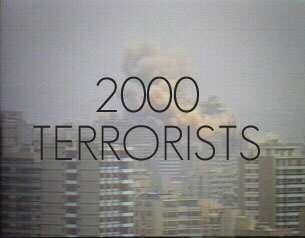2,000 Terrorists
What will be the legacy of Prime Minister Ariel Sharon? Will he be remembered as a man of peace or a war criminal? In the refugee camps of Lebanon, the shadow of the Sabra and Shatila massacre darkens every day.
 What will be the legacy of Prime Minister Ariel Sharon? Will he be remembered as a man of peace or a war criminal? In the refugee camps of Lebanon, the shadow of the Sabra and Shatila massacre darkens every day. Here, people regard Sharon as the man who authorised a genocide. Who ordered the Israeli army to surround the camps, let the Christian militias in and did nothing as they massacred thousands of innocent civilians. Our offering this week is the definitive documentary on Sabra and Shatila. It centres on four survivors who spearheaded the campaign to bring Sharon to trial. Includes shocking archive of the massacre.
What will be the legacy of Prime Minister Ariel Sharon? Will he be remembered as a man of peace or a war criminal? In the refugee camps of Lebanon, the shadow of the Sabra and Shatila massacre darkens every day. Here, people regard Sharon as the man who authorised a genocide. Who ordered the Israeli army to surround the camps, let the Christian militias in and did nothing as they massacred thousands of innocent civilians. Our offering this week is the definitive documentary on Sabra and Shatila. It centres on four survivors who spearheaded the campaign to bring Sharon to trial. Includes shocking archive of the massacre.
The first body the bulldozer uncovered was impaled on the teeth of its shovel. Nearby a woman weeps, prostrate with grief, as her relatives' bodies are dug up. It's days after militant Christians murdered thousands of civilians and the streets of Sabra and Shatila are littered with corpses.
On June 4, 1982, the Israeli army, led by Ariel Sharon, invaded Lebanon. Sharon later claimed that the goal of the operation was to "finish off Yasser Arafat, once and for all." But after months of fighting a cease-fire was agreed. In exchange for a guarantee that Palestinian civilians would be unharmed, Yasser Arafat and 14,000 PLO fighters left Lebanon.
A month later, following the murder of the Lebanese president, Israel invaded Beirut. "There are still 2,000 terrorists in Sabra and Shatila" declared Sharon. Archive footage shows Israeli tanks moving in to surround and seal off the camps. Later that day, they let in the Phalangists, a fanatically Christian militia. "The kids were playing when we heard the first gunshots. I went out and saw a girl who was shot. Then the shelling started," recalls Umm Hussein. "People were crying and screaming. Everyone was afraid."
At night, the Israeli army fired flares into the sky to help the Phalangists in their search for terrorists. "As we walked through Shatila street, we saw lots of people who were killed in unusual ways," recalls Sana Sersawi. "Our neighbour was tied up and his head cut open by an axe. His son was cut to pieces." Mahmoud Younes photographed his brothers' mutilated corpses. "They cut off my brother's legs and burnt him. He was 14."
The Sabra and Shatila massacre lasted 40 hours. Days later, the Israeli army entered the camp and seized the Palestinians prisoners abducted by the Phalangists. "Why are you detaining them for so long. Why can't they go?" begs a Palestinian woman to an Israeli soldier. "They never came back," despairs Sana. "Even today, we don't know whether they are dead or alive."
The 1982 massacre of Sabra and Shatila was officially defined as a genocide by the UN. But its victims had to wait 19 years to be heard. "There were no courts before which we could bring the case," explains Chibli Mallat, the victim' lawyer. "In such a high profile case, you cannot just accuse someone without solid evidence."
In June 2001, the survivors of the massacre used Belgium's genocide laws to file a case against Prime Minister Sharon and 19 others. Eli Hobeika, leader of the Phalangists, was prepared to testify against Sharon and documents seemingly implicated him. But under heavy diplomatic pressure, Belgium was forced to change its genocide laws and the case against Sharon collapsed.
However lawyer Michael Verharghe remains positive. "One day, the truth must and will be revealed."
FULL SYNOPSIS
